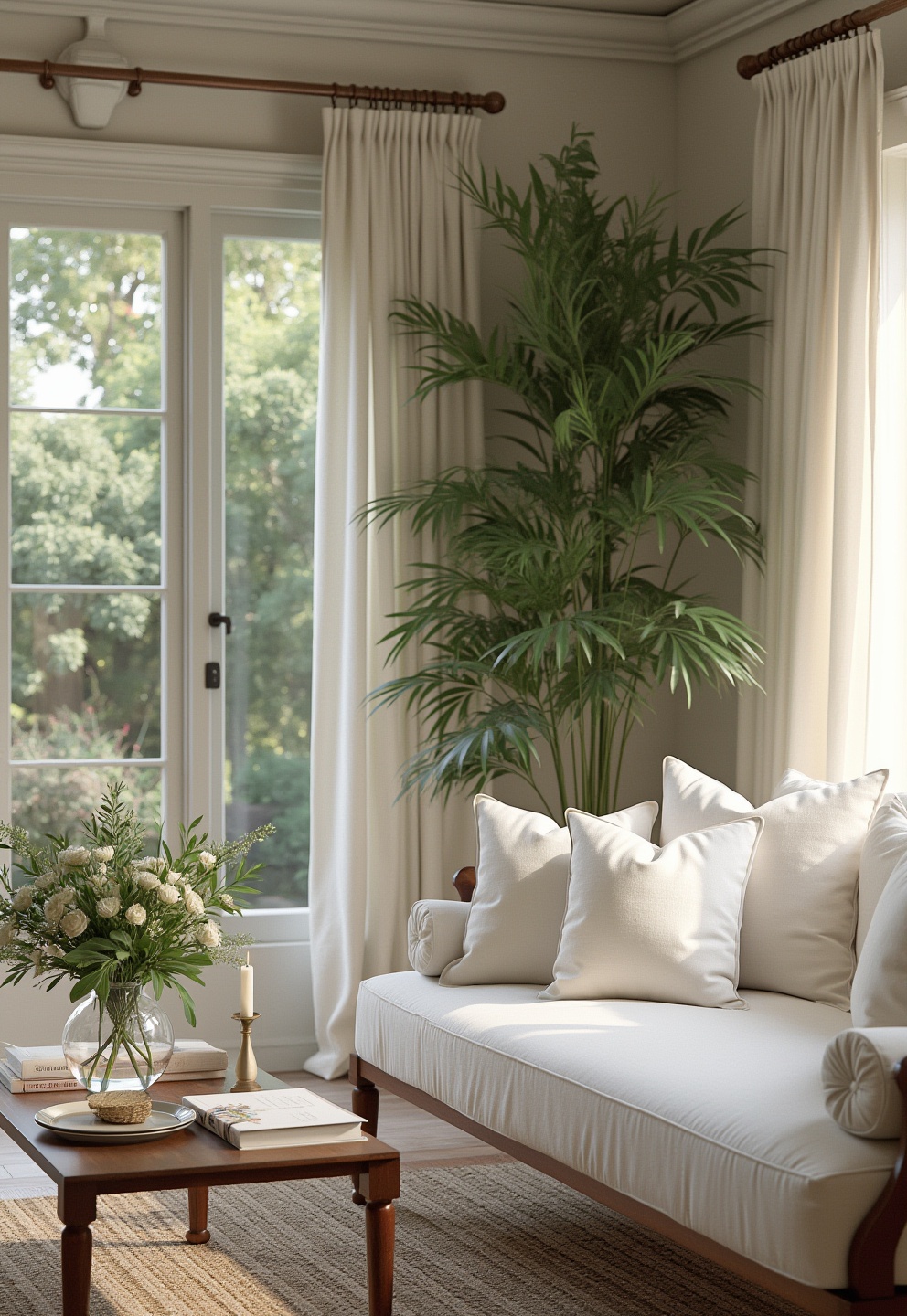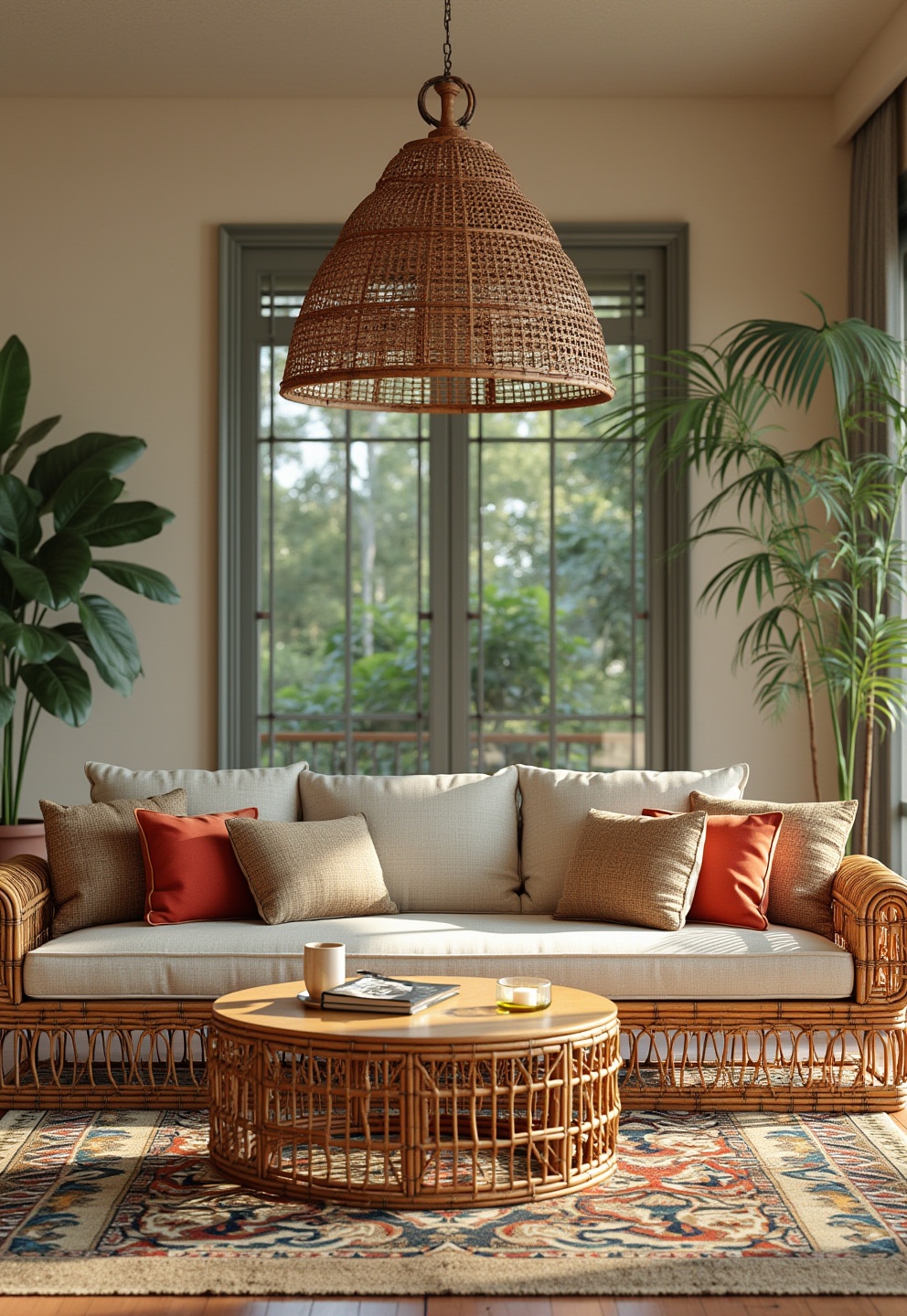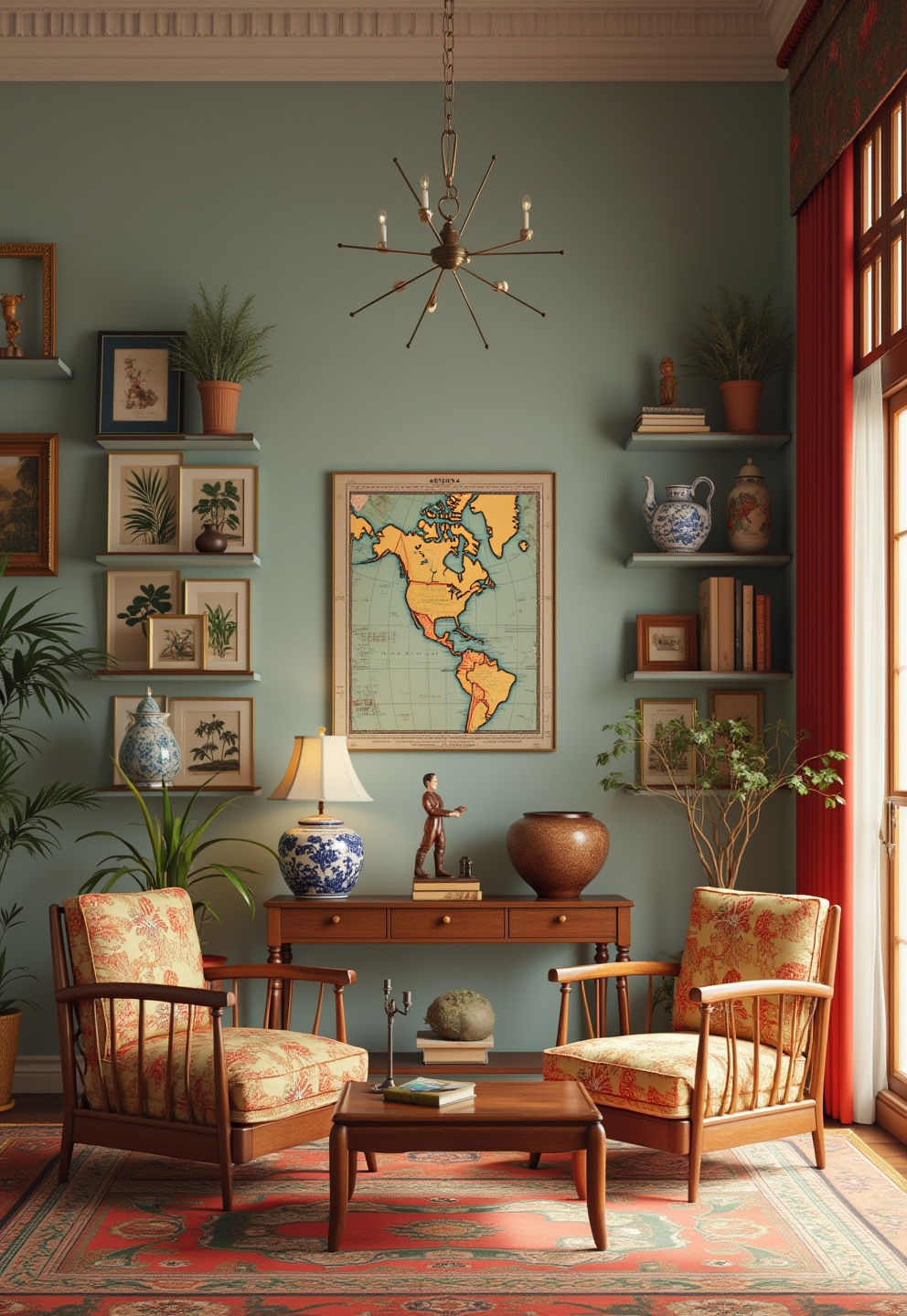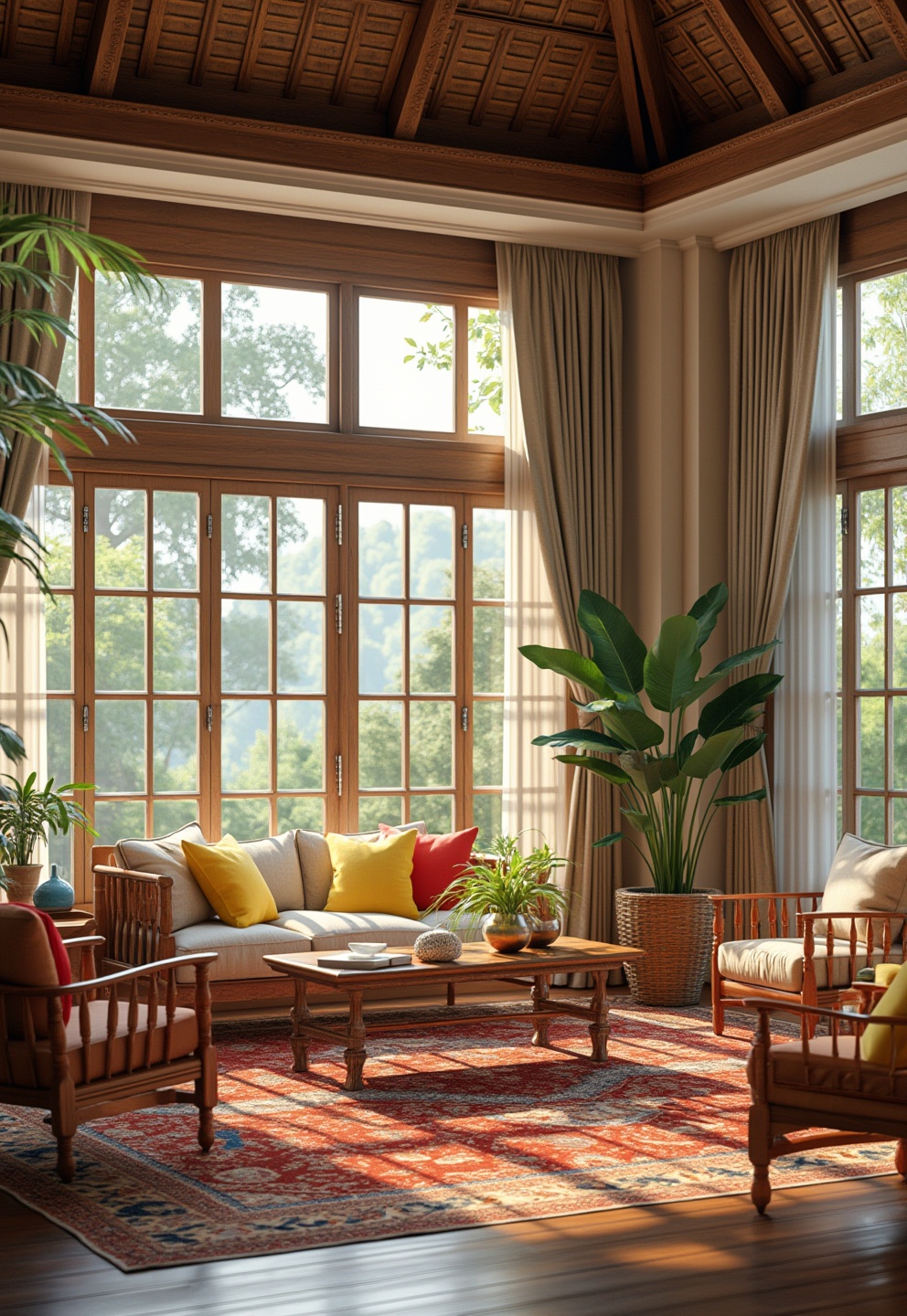15 British Colonial Style Living Room Ideas (Pure Elegance!)


British colonial style living rooms blend elegance and comfort. This design approach draws inspiration from the colonial era, showcasing a unique mix of tropical elements and classic British influences.
A well-designed British colonial living room often features natural materials, rich textures, and a relaxed atmosphere that welcomes both residents and guests.
Incorporating elements like rattan furniture, light-colored fabrics, and decorative accessories can create a serene yet sophisticated space. This style not only appeals to those who appreciate historical aesthetics but also to those looking to create a cozy retreat in their home.
1) Dark-stained Rattan Furniture

Dark-stained rattan furniture is a key element in British Colonial style living rooms. It adds a sense of warmth and elegance to the space. The natural texture of rattan combines well with darker wood tones.
This type of furniture is often crafted from strong materials like bamboo and timber. Rattan offers durability while providing a laid-back appeal. Its dark finish gives it a refined look that suits various decor.
Adding dark-stained rattan pieces can create contrast with lighter color schemes. This balance enhances the overall design, making rooms feel inviting and airy.
Comfort is also important in this style. Rattan furniture often features soft cushions covered in white or neutral fabrics. This combination provides a cozy atmosphere perfect for relaxation and socializing.
2) Pure White Linen Accents

Pure white linen accents are a key feature in British colonial style living rooms. They bring a fresh and airy feel to the space. These accents are often used in curtains, cushion covers, and upholstery.
Using billowy white linen curtains allows natural light to filter in while adding a soft touch. This helps to create an inviting atmosphere that complements the tropical influences of the style.
Cushions covered in pure white linen can enhance comfort and add contrast to darker furniture. The simplicity of white linen helps to highlight the rich tones of wood and rattan commonly found in British colonial design.
Overall, pure white linen accents contribute to a relaxed and sophisticated look. They help balance the vibrant colors often present in the decor. This choice is practical, as linen is durable and easy to clean, making it a smart option for any living room.
3) Contrast With Rich Wood

In British colonial style, rich wood plays a vital role in creating a warm and inviting atmosphere. Dark woods, such as mahogany or teak, are often used for furniture, providing a sense of luxury.
These dark furniture pieces contrast beautifully with lighter wall colors. This balance creates a sophisticated look that is both airy and refined. The use of natural materials adds depth to the design.
Incorporating rattan or cane accents can soften the overall appearance. These materials work well alongside dark wooden elements, enhancing the tropical vibe of the room.
Adding lush greenery with tropical plants can also enhance this contrast. The bright colors of the plants stand out against the dark wood, bringing life to the space.
4) Incorporate Tropical Plants

To enhance a British colonial style living room, introducing tropical plants is essential. They add life, color, and a sense of warmth to the space.
Potted palms are a popular choice. They can be placed in corners or beside furniture to create an inviting atmosphere. Their tall and graceful appearance fits well with the style.
Other options include fig trees and ferns. These plants offer rich greenery that complements the natural materials often found in British colonial design.
Using woven baskets as plant holders can also enhance the tropical theme. This combination of plants and natural textures brings the outdoors inside.
Arranging plants on dining tables or side tables adds another layer of interest. A mix of heights and types keeps the decor dynamic and visually appealing.
Incorporating these elements effectively transforms the living room into a bright and welcoming space that reflects the elegance of British colonial style.
5) Natural Materials Like Bamboo

Bamboo is a key feature in British Colonial style living rooms. This material is valued for its beauty and strength, making it a popular choice for furniture and decor.
Using bamboo helps create an airy and open atmosphere. Its light appearance complements the bright colors often found in colonial design.
Bamboo furniture typically includes chairs, tables, and decorative accents. These pieces can bring a touch of nature indoors while maintaining a sophisticated look.
In addition to bamboo, other natural materials like rattan and woven grass also enhance this style. They add texture and warmth to the space, which is essential for a cozy environment.
Choosing these materials supports a sustainable lifestyle. Bamboo is a renewable resource, making it an eco-friendly option in home design.
Incorporating bamboo into the living room design not only embraces tradition but also promotes modern environmental awareness. This blend makes it a perfect fit for today’s homes.
6) Cultural Artifacts From Asia

Cultural artifacts from Asia play a significant role in British Colonial style living rooms. These items add depth and character to the space. They reflect a history of travel and trade between cultures.
Vintage maps often serve as wall art. They showcase exploration and bring a sense of adventure to the decor.
Incorporating botanicals, like prints of exotic plants, highlights the region’s natural beauty. They add a fresh, vibrant touch to the room.
Artifacts such as carved wooden figures or pottery can also be focal points. These pieces of craftsmanship demonstrate skill and tell unique stories from different cultures.
Textiles from Asia, including silk and embroidered fabrics, can enhance cushions or curtains. They introduce rich colors and textures that complement the overall design.
By carefully selecting these artifacts, one can create a cohesive look that celebrates the blend of British and Asian influences. Each piece serves as a reminder of a shared history and adds a sophisticated touch to the living space.
7) Colonial Era Maps On Walls

Colonial era maps can add a unique touch to a living room designed in British Colonial style. These maps reflect the exploration and history of the time, showcasing places like the West Indies and other territories.
Hanging a vintage map as wall art brings a sense of adventure to the space. It serves as a conversation starter and allows for a glimpse into the past.
Maps in dark frames can complement furniture made of rattan or timber. This combination enhances the relaxed, genteel atmosphere typical of colonial decor.
Digital downloads of antique maps can also be found for those looking for easy accessibility. Online marketplaces offer a variety of options, making it easy to find the perfect piece.
Incorporating colonial maps enriches the overall aesthetic of a living room while honoring historical influences. The details in these maps can tie different elements of the room together beautifully.
8) Textured Sea-grass Rugs

Textured sea-grass rugs add a natural, warm touch to a British Colonial style living room. They offer a blend of durability and style, making them a popular choice for many homeowners.
These rugs are made from natural fibers, which provide an organic look that complements wooden furniture and light color palettes. Their neutral tones help to unify different design elements in a room.
Sea-grass rugs are also easy to maintain. They can withstand heavy foot traffic and are less prone to staining compared to other rug types. This makes them suitable for both casual and formal spaces.
In a British Colonial inspired setting, textured sea-grass rugs can enhance the overall aesthetic. They pair well with other materials like leather and cotton, creating a harmonious environment that reflects the charm of colonial design.
Adding a sea-grass rug can elevate the comfort of the room while remaining stylish and functional.
9) Blue And Green Color Palette

A blue and green color palette is essential in British Colonial style living rooms. These colors reflect the tropical and coastal influences of colonial times. Darker blues and various shades of green evoke a sense of calm and natural beauty.
Accent colors like muted reds and yellows can enhance the palette. These tones add depth and character to the space. They can be used in cushions, artwork, or decorative items.
When choosing paint colors, opt for soft blues or rich greens for the walls. These colors create a serene backdrop for furniture and decor. Neutral tones can also balance the bolder colors, making the room feel inviting.
Incorporating patterns is another option. Stripes or floral designs in blue and green can add interest without overwhelming the space. They can be included in fabrics or wallpapers to complete the look.
This color palette works well with natural materials like wood and rattan. These elements tie together the colonial aesthetic with a modern touch.
10) Leather And Timber Elements

Leather and timber are key features of British Colonial style living rooms. They add warmth and texture to the space. Rich, dark wood furniture enhances the look, bringing an elegant touch.
Timber can come from various sources like mahogany or teak. These woods are durable and often have beautiful grain patterns. Using wooden pieces allows for a classic and sophisticated appearance.
Leather accents, such as sofas or armchairs, offer comfort while adding a sense of luxury. Distressed leather, in particular, fits well with this style. It complements the natural look of wood.
Together, leather and timber create a balanced and inviting atmosphere. They embody the fusion of British sophistication with tropical flair. This mix captures the essence of colonial living beautifully.
11) Light Walls Against Dark Wood

Using light-colored walls can create a beautiful contrast with dark wood features. This design choice adds depth and brightness to a room, making it feel more open and airy.
Pale shades like soft greens or blues are popular in British colonial style. These colors pair well with the richness of dark timber furniture and accents.
Light walls also help to reflect natural light. This effect enhances the overall atmosphere, making the living space more inviting.
When combined with dark wood, light walls can highlight architectural details and furnishings. The balance between the two elements brings a harmonious look to the room.
Rattan or wicker furniture often complements this style. These materials add texture while sticking to the light and dark theme.
12) Decorative Ceiling Fans

Decorative ceiling fans add both style and function to a British colonial style living room. They often feature natural materials and intricate designs that reflect the tropical aesthetic of this decor theme.
Fans made from woven bamboo or palm leaves complement the warm colors and textures typical of British colonial design. A popular choice is the Islander fan, which has been favored for its elegant look and durability.
The size of the fan is important. A 52-inch diameter provides ample airflow without overwhelming the space. Models with integrated lighting can also enhance the room’s ambiance.
Choosing a fan with a remote control adds convenience. This allows for easy adjustment without needing to get up. Traditional designs can create a timeless feel in any living space, making them a perfect fit for this interior style.
For those interested in exploring different options, various online platforms showcase a range of decorative ceiling fans suitable for this theme. A selection can be found at Fanco and Pinterest, where inspiration abounds.
13) Vintage Globe As Decor

A vintage globe can add a unique touch to a British colonial style living room. It serves as both a decorative item and a conversation starter.
These globes often feature aged colors and antique finishes. This makes them a perfect fit for the classic and refined look of British colonial design.
Placing a vintage globe on a shelf or side table enhances the room’s aesthetic. It can reflect a sense of history and exploration, common themes in this style.
Many vintage globes, like the reproduction of a mappemonde from 1949, showcase important historical transitions. Such details can spark interest in world events and geography.
Incorporating a vintage globe into the decor also ties in well with other elements, such as rich woods and tropical plants. This creates a cohesive and inviting environment.
14) Large Windows With Voile Curtains

Large windows are a hallmark of British Colonial style. They allow natural light to flood the room, creating a bright and inviting atmosphere.
Voile curtains complement these windows beautifully. Their lightweight, sheer fabric filters sunlight while still offering some privacy. This balance enhances the spacious feel of the room.
The combination of large windows and voile curtains adds to the airy ambiance typical of British Colonial design. It invites the outside in, connecting the indoor space with nature.
This style also embraces tropical elements. Voile curtains can sway gently with the breeze, echoing the coastal influences found in many British Colonial homes.
Choosing neutral or soft colors for voile curtains can highlight the rich wood tones often used in British Colonial furniture. This creates a harmonious look that feels both elegant and relaxed.
15) Ornate Wooden Room Dividers

Ornate wooden room dividers can add a touch of elegance to a British Colonial style living room. These dividers often feature intricate carvings and details that showcase craftsmanship.
They are typically made from rich woods like mahogany or teak. The natural beauty of the wood enhances the warm and inviting atmosphere characteristic of this style.
Many room dividers include motifs inspired by colonial designs, such as floral patterns or geometric shapes. This can provide a cohesive look within the space.
Lightweight dividers can be easily moved, allowing for flexibility in room arrangement. They can also create separate areas without losing the open feel of the space.
For a vintage touch, pieces from the 70s, like the burnt bamboo room divider, blend well with the British Colonial aesthetic. This type of divider offers charm and functionality, making it a practical choice for any living area.
Historical Context and Influence
British Colonial style originated during the height of the British Empire, influenced by the various regions under British rule. Each area contributed unique characteristics to the design.
Colonial homes often featured large windows and open spaces to accommodate the hot climates of tropical regions. The style also embraced local craftsmanship and materials, leading to a rich fusion of cultural elements.
This design ethos allowed for functionality while ensuring spaces remained inviting. The use of traditional English design meets local flair, resulting in a style that is both historical and modern.
Common Materials and Textures
Key materials in British Colonial design include dark woods like mahogany, teak, and ebony. These woods add richness and warmth to the space, providing a solid base for furniture and flooring.
In addition to wood, lightweight fabrics such as cotton and linen are used for curtains and upholstery. These materials facilitate airflow while contributing to the style’s airy ambiance.
Rattan and bamboo accents are common, often seen in furniture and decorative items. Such textures create a contrast with the dark woods, adding visual interest and a tropical feel.
Together, these materials create a harmonious environment that is functional and luxurious, reflecting the elegance of the British Colonial era.








